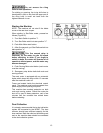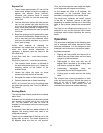21
Square Cut
1. Take a panel approximately 40" and cut five
times round, always turning the cut edge up
against the crosscut fence (counter-
clockwise with crosscut fence in normal
position). The fifth cut cuts the same edge
as the first.
2. The last offcut strip (whose left side was the
last cut and whose right side was the first
cut) must be the same width at both ends if
every corner was precisely 90 degrees. Any
error in the squareness has been multiplied
four times.
3. Break the strip and lay the ends side by side
and check the difference. (Break the strip in
such a way that you know afterward which
was front and which was back; e.g. front bit
short, back bit long).
Unlike other methods of checking for
squareness, this system tells you which way to
move the fence should adjustment be
necessary. It depends upon the shape of the
fifth offcut strip:
If front thick, back thin – move fence counter-
clockwise.
If front thin, back thick – move fence clockwise.
1. The crosscut fence position is adjusted at
the outer attachment point only. Loosen the
clamping device on the bottom of the
crosscut fence.
2. Loosen the adjust the cross cut fence
bracket on the top surface of the table.
3. Re-tighten the cross cut fence clamp device.
4. Perform another test to check the setting.
NOTE: An incorrect free cut on the sliding table
can affect the squaring; see "Free Cut (Blade to
Rip Fence)"
Scoring Blade
The scoring blade should penetrate the material
about 2mm.
Problems with the alignment of the scoring blade
can normally be traced back to too much free
cut. For this reason, the free cut must be
checked for correctness before the scoring saw
is adjusted.
For example, when the main blade is tilted to 45
degrees, the scoring blade may need to be
readjusted sideways.
The tilt axis is independent of the free cut on the
sliding table rip fence. The scorer alignment at
90 degrees takes the free cut into account.
Thus, the scorer and the main blade are slightly
out of alignment with regard to the tilt axis.
As the blades are tilted to 45 degrees, this
misalignment in the horizontal plane also
becomes a misalignment in the vertical plane.
The scorer must, therefore, be "raised" (moved
to the left) or "lowered" (moved to the right)
depending on whether the free cut on the sliding
table, or the rip fence, needs to be compensated
for.
The free cut can influence the scoring cut; it is
essential to carry out the first two free-cut tests
mentioned above before adjusting the scoring
blade.
Operation
The panel saw is designed for the following work
and is equipped with safety devices for these
particular procedures. It is not designed to work
materials such as ferrous or non-ferrous metals.
Available procedures:
• Ripping with the parallel saw fence with or
without the saw blade tilted and the fence
upright or in the low position.
• Right-angled or mitre cuts with the 90
degree fence mounted to the sliding table
with tilted or vertical saw blade.
• Crosscutting workpieces using the
adjustable stop on the 90 degree fence.
• Cutting panels or solid wood on the sliding
table.
The machine has overload protection on both
main and scoring motors. Should the motor be
shut off by one of these protectors, it is
necessary to wait a few minutes until the
overload has cooled down before restarting.


















